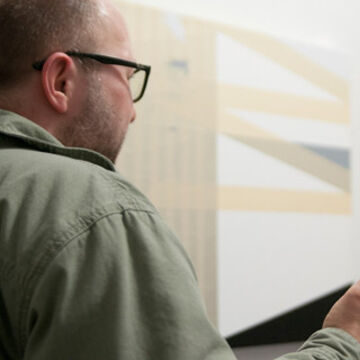| Painting Practice |
Painting and Drawing |
2001 (007) |
Fall 2024 |
|
Description
Painting Practice is an introductory painting course offering. The curriculum addresses basic skills as related to a painting studio practice. Topics and curricular goals include material, facility and technique, space and color, as well as concept. This course is a prerequisite for all Multi-level Painting, Figure Painting and Advanced Painting Studio classes.
|
Class Number
1919
Credits
3
|
| Color |
Painting and Drawing |
2003 (001) |
Spring 2024 |
|
Description
This studio course will provide a hands-on introduction to the fundamental understanding and use of color. Students will gain practical experience working with material color in order to improve their understanding of how color works. Assignments will be introduced in class to help students develop a working knowledge of the basic concepts of hue, value, and chroma, and the relationship between these concepts and those of color harmony and organization. By working with color in context students will gain a practical understanding of color interaction and develop strategies for approaching color with greater sophistication and specificity in their own practice. In addition to our investigations with color in the classroom, this course will examine the ways in which artists and scholars have worked with color art historically as a medium of expression, and thought about color scientifically as an index of an underlying natural order, as well as culturally as a system of signs reflecting our biases back to us to be interpreted. Reliable perceptual phenomena like simultaneous contrast and afterimages will be considered alongside more unstable notions like synesthesia and color music, as well as the complicated history of thinking about color as evidence of that which is ?other.? Course work will include exercises to help students develop their approach to color, and a final project in which they put their understanding to work.
|
Class Number
1897
Credits
3
|
| Color |
Painting and Drawing |
2003 (002) |
Fall 2024 |
|
Description
This studio course will provide a hands-on introduction to the fundamental understanding and use of color. Students will gain practical experience working with material color in order to improve their understanding of how color works. Assignments will be introduced in class to help students develop a working knowledge of the basic concepts of hue, value, and chroma, and the relationship between these concepts and those of color harmony and organization. By working with color in context students will gain a practical understanding of color interaction and develop strategies for approaching color with greater sophistication and specificity in their own practice. In addition to our investigations with color in the classroom, this course will examine the ways in which artists and scholars have worked with color art historically as a medium of expression, and thought about color scientifically as an index of an underlying natural order, as well as culturally as a system of signs reflecting our biases back to us to be interpreted. Reliable perceptual phenomena like simultaneous contrast and afterimages will be considered alongside more unstable notions like synesthesia and color music, as well as the complicated history of thinking about color as evidence of that which is ?other.? Course work will include exercises to help students develop their approach to color, and a final project in which they put their understanding to work.
|
Class Number
1944
Credits
3
|
| Std Draw:Large Format |
Painting and Drawing |
2040 (002) |
Fall 2024 |
|
Description
How big is big? Does the size of a drawing alter our ideas of what we?re about while we?re producing it? How do relationships of internal scale alter our sense of the surrounding space, and how do the sizes of the materials and the support alter our own awareness of scale? In this course we will explore the potential for large format drawing in the perceptual, material, narrative and conceptual senses. We will work towards expanding notions of Large, Format, Studio and Drawing. We will work towards specificity and developing each student's individual concerns. Bring your ambition, you'll need it. Most time in class will be spent working on studio projects, which will be supplemented by museum visits, slide lectures, student led reading discussions and presentations, and in depth critique. Readings and artists looked at will vary, but will typically include texts which attempt a broad overview of the state of drawing within the field of contemporary art like Vitamin D2 and Drawing Now: Eight Propositions, and include contemporary artists working with drawing at ambitious scale such as Toba Khedoori, Amy Sillman, and William Kentridge, and more historical examples like Willem de Kooning, Cy Twombly, Lee Krasner, and Jasper Johns. There will be a long form mid-term critique and a shorter final critique. Students will be expected to complete multiple large scale works for each.
|
Class Number
1885
Credits
3
|
| Painting Studio A: Multi-Level |
Painting and Drawing |
3001 (005) |
Spring 2024 |
|
Description
This course investigates painting materials, application, color, form, and ideas through contemporary and traditional methodologies. Designed to accommodate many skill levels, students can explore various creative strategies through a skill-based curriculum as well as individual projects. This course serves as a requirement and preparation for topic-based Painting Studio Multi-Level B classes.
|
Class Number
1864
Credits
3
|
| Painting Studio A: Multi-Level |
Painting and Drawing |
3001 (008) |
Spring 2024 |
|
Description
This course investigates painting materials, application, color, form, and ideas through contemporary and traditional methodologies. Designed to accommodate many skill levels, students can explore various creative strategies through a skill-based curriculum as well as individual projects. This course serves as a requirement and preparation for topic-based Painting Studio Multi-Level B classes.
|
Class Number
1867
Credits
3
|

